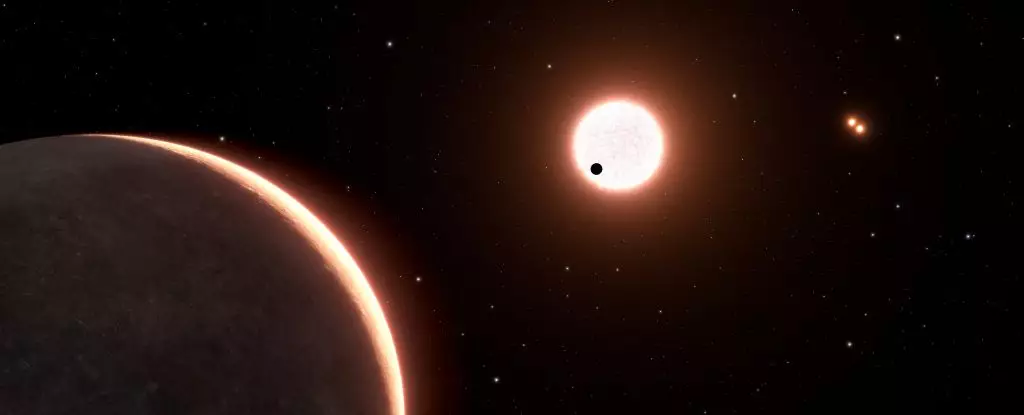Scientists in the US have recently confirmed the existence of an exoplanet called LTT 1445 Ac, which orbits a small red dwarf star only 22 light-years away from our Solar System. What makes this discovery particularly significant is that LTT 1445 Ac is the closest known Earth-sized world to us. While this exoplanet is too hot to sustain life, its similarity to our own planet opens up exciting opportunities for studying planetary evolution and the factors that make different Earth-like worlds distinct from each other.
LTT 1445 Ac resides in an intriguing system consisting of three gravitationally bound stars, known as a trinary system. The presence of multiple stars complicates the process of observing and studying exoplanets. When we search for exoplanets by analyzing changes in the light of the host star, the stellar companions also have an impact on the light emitted by the other stars in the system. Despite the relative proximity of 22 light-years, directly studying an Earth-sized exoplanet poses a great challenge due to its minuscule size.
To gather information about the properties of an exoplanet, scientists ideally require two types of measurements. The first is transit data, which involves capturing the small dips in starlight that occur when an exoplanet passes between the star and Earth. These dips provide valuable details about the radius of the exoplanet. The second type of measurement is radial velocity data, which allows scientists to determine the exoplanet’s mass by analyzing changes in the wavelength of starlight as it subtly wobbles due to the gravitational tug of the exoplanet. Combining the radius and mass measurements enables scientists to calculate the density and infer the composition of the exoplanet.
In the case of LTT 1445 Ac, the initial identification of the exoplanet utilizing data from the TESS exoplanet-hunting telescope faced some difficulties. The data acquired by TESS was not well-resolved, making it challenging to ascertain whether the dimming of starlight was caused by the exoplanet entirely eclipsing the star or just partially grazing its disc. While radial velocity data confirmed the presence of the exoplanet, high-resolution transit data was needed to deepen our understanding of its properties.
The Hubble Space Telescope played a crucial role in overcoming the challenges faced in studying LTT 1445 Ac. Astrophysicist Emily Pass, leading a team from the Harvard & Smithsonian Center for Astrophysics, utilized Hubble’s Wide Field Camera 3 to observe the LTT 1445 system and search for transits of LTT 1445 Ac. While some light dips observed in the system were attributed to the interactions between the three stars, the team successfully captured the exoplanet as it crossed in front of the star. This breakthrough allowed Pass and her colleagues to measure the diameter of LTT 1445 Ac with high precision.
Based on the radius and mass measurements, researchers deduced that LTT 1445 Ac has a density of 5.9 grams per cubic centimeter. In comparison, Earth has a density of 5.51 grams per cubic centimeter. This finding suggests that LTT 1445 Ac is likely a rocky exoplanet, similar in size and composition to our planet. Despite its proximity to Earth, LTT 1445 Ac is inhospitable to life as we know it due to its orbital period of only 3.12 days, resulting in an average temperature of around 260 degrees Celsius (500 degrees Fahrenheit).
The availability of clear transit data for LTT 1445 Ac opens up possibilities for examining its atmosphere. Characterizing this exoplanet further will provide valuable insights into the formation and evolution of Earth-like worlds in different system architectures. Understanding these factors will contribute to our knowledge of the likelihood of life’s emergence in other parts of our galaxy. Pass emphasizes the significance of this measurement, highlighting that the ability to study the atmospheres of transiting planets, not just with Hubble but also with the upcoming James Webb Space Telescope, is an exciting prospect.
The discovery of LTT 1445 Ac as the closest known Earth-sized exoplanet provides scientists with an invaluable opportunity to deepen our understanding of the formation and nature of Earth-like worlds. While this exoplanet itself may not host life, its proximity and clear transit data will aid in exploring the characteristics of exoplanetary atmospheres, paving the way for future discoveries and insights into the potential for life elsewhere in the universe.


Leave a Reply